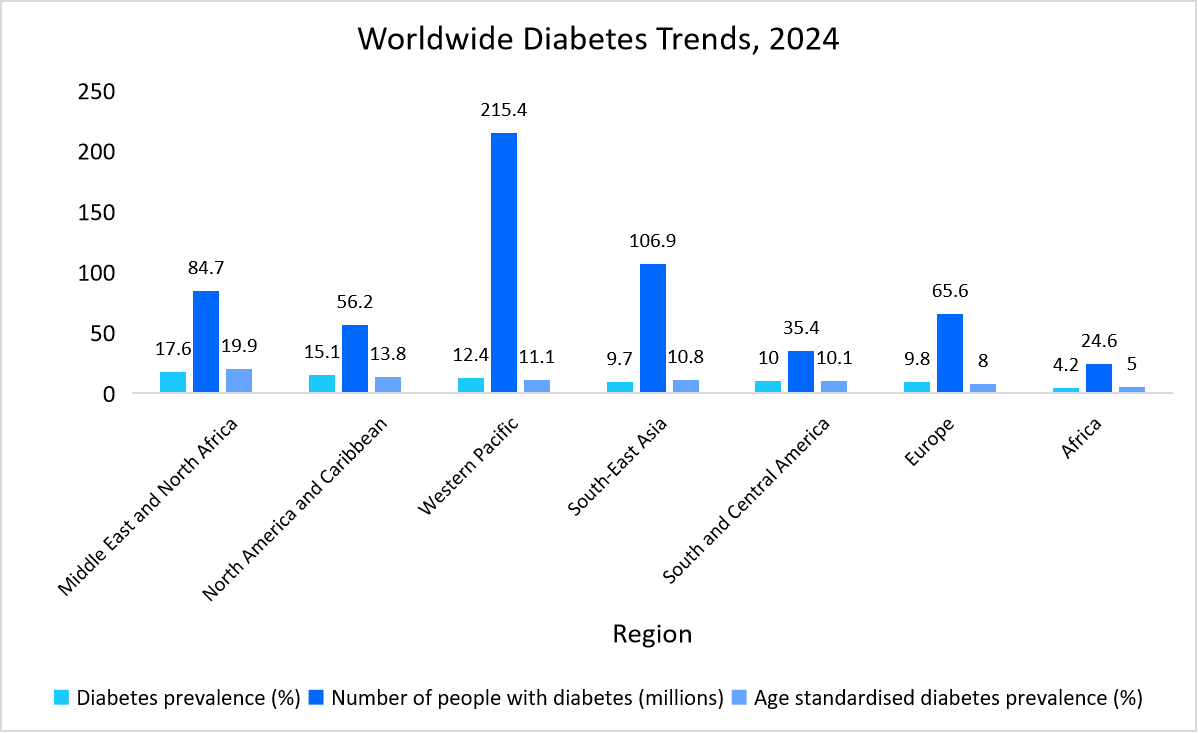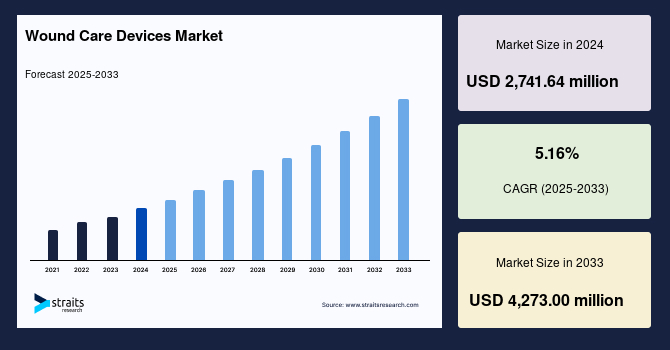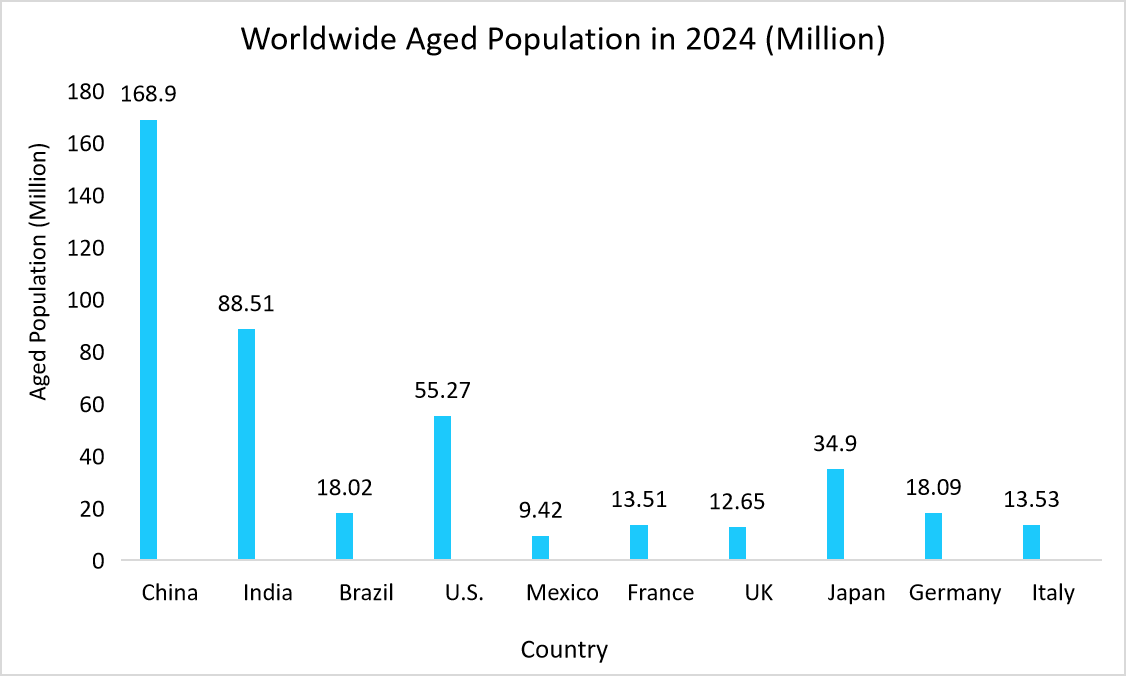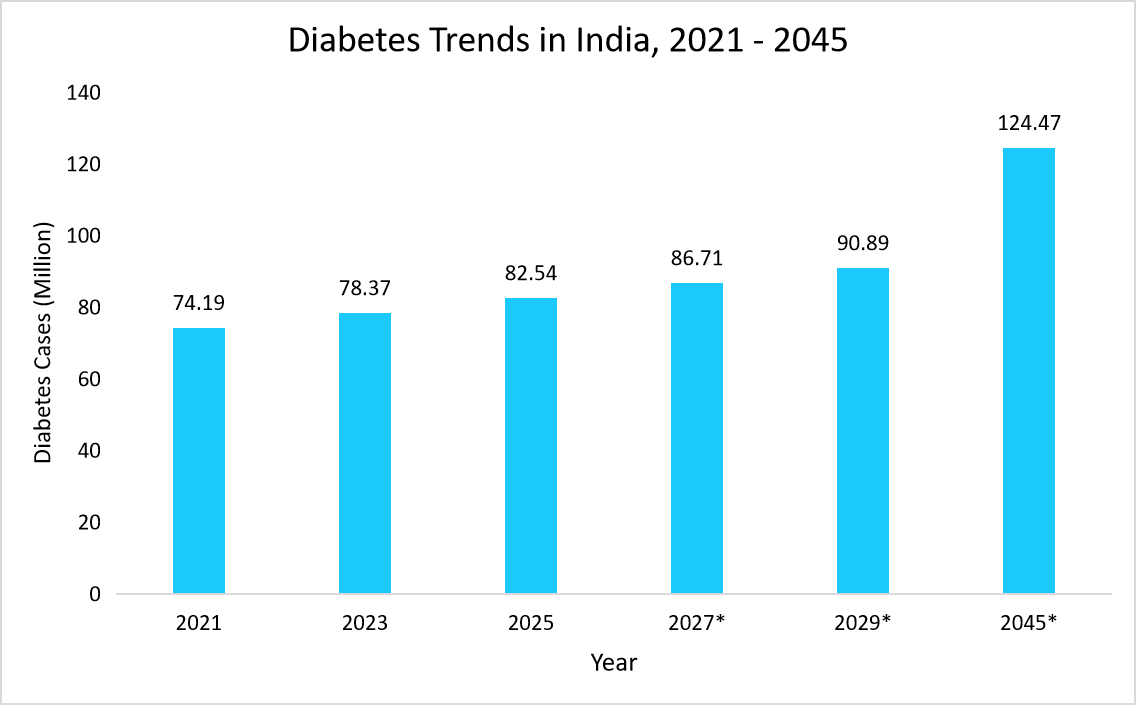Wound Care Devices Market Size
The global wound care devices market size was valued at USD 2,741.64 million in 2024 and is projected to grow from USD 2,857.62 million in 2025 to USD 4,273.00 million by 2033, exhibiting a CAGR of 5.16% during the forecast period (2025-2033).
The major factors contributing to the growth of wound care devices industry are increasing prevalence of chronic wounds such as diabetic foot ulcers, pressure ulcers, and venous leg ulcers, associated with growing aging population worldwide. In addition, technological advancements in developing more user-friendly, portable wound care device along with digital monitoring solutions are enhancing treatment effectiveness and patient comfort, thus driving better patient compliance and higher adoption rates. Further, growing focus on evidence-based clinical and multidisciplinary wound care treatment, contribute to innovation and accessibility, thereby positioning wound care device a critical component in addressing the global burden of chronic wounds.
- For instance, the graph below shows the regional prevalence of diabetes, highlighting how areas such as Western Pacific and South-East Asia have the highest rates, which directly impacts the demand for effective chronic wound management solutions such as diabetic foot ulcers.

Source: International Diabetes Federation, World Health Organization (WHO), and Straits Research
Wound Care Devices Market Trends
Shift toward Patient-Centered Wound Care
An emerging trend in the wound care industry is the shift toward patient-centered care, emphasizing convenience, comfort, and greater autonomy. This trend has accelerated the development of user-friendly and portable wound care devices that support at-home management and improve patient adherence.
- For example, the table below highlights major manufacturers offering instillation NPWT devices, along with key features that align with the trend toward patient-centered care.
Instillation NPWT Device Manufacturers and Their Core Capabilities
|
Manufacturer |
Product |
Key Features (Therapy Modes) |
|
Solventum |
3M Veraflo Therapy |
· Instillation therapy · Continuous therapy |
|
Guangzhou Rainhome Pharm & Tech Co., Ltd. |
Instill negative pressure wound therapy machine |
· Instillation therapy · Continuous therapy · Dynamic therapy · Intermittent therapy · Cleansing wound therapy |
|
CONFORT |
C500 NPWT Therapy Unit |
· Continuous therapy · Interval therapy · Instillation therapy · Instillation intermittent therapy |
Source: Company Product Portfolio, and Straits Research
Thus, such innovations enhance the overall patient experience along with reducing the burden on healthcare facilities by limiting in-person visits and enabling remote wound monitoring, thereby propelling the broader shift towards decentralized care.
Integration of Telemedicine and Digital Health in Wound Care
The growing adoption of telemedicine and digital health technologies is transforming the chronic wound care segment by enabling remote monitoring and management of wounds. These solutions enhance access and ensure continuity of care, which is especially important for patients with chronic wounds. The COVID-19 pandemic further accelerated this trend by emphasizing the necessity of remote healthcare delivery.
- For example, the table below highlights key players integrating telemedicine and digital health technologies into wound care, showcasing their innovative solutions and features that support remote monitoring and decentralized care.
Examples of Digital Health Integration in Wound Care
|
Company |
Solution |
Key Features |
|
Swift Medical Inc. |
Swift Skin and Wound |
AI-powered remote wound assessment via smartphone images. |
|
Net Health |
WoundExpert EHR |
AI-driven wound tracking integrated with clinical workflows. |
|
eKare Inc. |
Insight 3D Wound Imaging System |
3D wound measurement and analytics with telehealth integration. |
|
Healthy.io |
Minuteful for Wound |
Smartphone-based wound assessment with AI-powered imaging and remote monitoring. |
|
Adiuvo Diagnostics |
Illuminate |
AI-driven hyperspectral imaging device for rapid, non-invasive wound infection detection. |
|
KroniKare Pte Ltd |
KroniKare Wound Scanner |
Portable multi-spectral device for automated wound assessment and monitoring. |
Source: Company Product Portfolios, Straits Research
Thus, the rise in remote wound management is boosting demand for smart wound care devices such as integrated NPWT systems, sensor-based dressings, and home-use monitoring tools thereby, supporting decentralized, patient-centric care.

To get more insights about this report Download Free Sample Report
Wound Care Devices Market Growth Factors
Escalating Chronic Conditions Are Driving Wound Care Demand
The rise in chronic conditions such as diabetes, obesity, and vascular diseases is leading to a higher incidence of slow-healing wounds.
- For instance, the graph below highlights the global rise in diabetes prevalence, underscoring the growing demand for specialized wound care interventions worldwide.

Source: International Diabetes Federation, World Health Organization (WHO), and Straits Research (* indicate projections)
Further, according to the International Diabetes Federation, diabetes-related neuropathy affects approximately 1 in 2 people living with diabetes, significantly increasing the risk of chronic wounds. These wounds often require long-term, advanced care solutions such as NPWT devices, hyperbaric oxygen therapy systems, and electrical stimulation devices.
Thus, as the global chronic disease burden grows, so does the need for efficient wound care technologies to manage complications and improve patient outcomes.
Availability of Reimbursement Schemes for Wound Care Devices
Reimbursement schemes are a key factor driving the adoption and growth of advanced wound care devices. By providing financial coverage for costly treatments, these schemes help reduce economic barriers and encourage healthcare providers to incorporate innovative technologies such as negative pressure wound therapy (NPWT).
- For example, in the U.S., Medicare’s 2025 Physician Fee Schedule specifies reimbursement rates for NPWT devices, including Pensar Medical’s NPWT system, based on wound size and care setting. This structured reimbursement makes NPWT therapies more accessible and affordable for both providers and patients, facilitating wider adoption.
Medicare Reimbursement Rates for Pensar Medical’s NPWT Device
|
Product Name |
End User |
Procedure Code |
Description |
2025 MPFS Allowable Rates Non-Facility ($) |
2025 MPFS Allowable Rates Facility ($) |
|
tNPWT |
Hospital Outpatient |
97605 |
NPWT for wounds ≤ 50 cm² |
42.05 |
23.61 |
|
Physicians / QHPs |
97606 |
NPWT for wounds > 50 cm² |
50.14 |
25.55 |
|
|
sNPWT |
Hospital Outpatient |
97607 |
NPWT for wounds ≤ 50 cm² |
399.53 |
|
|
97608 |
NPWT for wounds > 50 cm² |
399.53 |
|||
|
Physicians / QHPs |
97607 |
NPWT for wounds ≤ 50 cm² |
323.14 |
20.38 |
|
|
97608 |
NPWT for wounds > 50 cm² |
337.05 |
23.61 |
||
|
Home Healthcare |
A9272 |
NPWT for wounds |
276.57 |
||
Source: U.S. Centers for Medicare & Medicaid Services, Pensar Medical Reimbursement Guidelines, and Straits Research
Thus, this structured reimbursement enables wider adoption by lowering treatment costs for providers and patients.
Market Restraining Factor
Availability of Alternative Therapies Restrains Device Adoption
The widespread use of advanced wound care products such as antimicrobial dressings, bioengineered skin substitutes, and topical growth factors presents a restraint for device-based therapies such as NPWT, oxygen therapy systems, and electric stimulation devices. These alternatives are often easier to apply, require less specialized equipment, and are more cost-effective, especially in outpatient or home care settings.
Thus, clinicians may prefer these non-device options over complex wound care devices, slowing the adoption and market penetration of wound care devices.
Market Opportunity
Specialized Wound Care Clinics: Catalysts for Market Expansion
The increasing number of specialized wound care clinics presents a significant opportunity for growth in the wound care devices market, as these clinics focus exclusively on treating complex and chronic wounds using advanced protocols.
- For example, MJH Life Science reports that over 2,200 specialized wound clinics across the U.S. provide advanced wound care solutions, driving greater adoption of innovative therapies.
This growth leads to several key opportunities:
- Expand product adoption: Clinics’ use of innovative therapies such as negative pressure wound therapy (NPWT) in combination with advanced dressings and smart monitoring devices opens doors for new and improved device offerings.
- Enhance collaboration and partnerships: Engaging with specialized clinics enables companies to tailor solutions that improve patient outcomes and meet clinical needs.
- Increase market awareness and reach: As clinics raise awareness of advanced wound care benefits, there is an opportunity to capture a broader patient base through earlier intervention and specialized treatment options.
Thus, the expansion of specialized wound care clinics offers opportunities for innovation, product diversification, and faster market growth.
Regional Insights
North America accounted for the largest share of the wound care devices market, with 38.01% of the revenue, owing to strong healthcare infrastructure, high adoption of advanced technologies such as NPWT, well-established reimbursement schemes, and increasing prevalence of chronic wounds and diabetes. Additionally, rising awareness about effective wound management and substantial investments in healthcare innovation further drive market growth in the region.
U.s. Wound Care Devices Market Trends
- U.S.- The U.S. wound care devices industry is experiencing strong growth driven by advanced therapies such as NPWT, HBOT, ESWT, and ultrasound, alongside supportive Medicare reimbursement for wound care treatments. Further, presence of over 2,200 specialized wound care clinics and increased government spending on wound care further fuel expansion. Furthermore, presence of established manufacturers such as Solventum, SANUWAVE Health, Inc., Cork Medical, and Healogics drive innovation and market development.
- For instance, the table below provides a comparison of wound care spending across the top countries, highlighting the U.S. as the leader in wound care spending with USD 166.15 billion, underscoring its focus on advanced treatment and diagnostics.

Source: Articles, Government Publications, and Straits Research
Asia Pacific Wound Care Devices Market Trends
Asia Pacific region is anticipated to grow at fastest CAGR of 6.80% during the forecast period. This growth is driven by increasing prevalence of chronic conditions such as diabetes and obesity which significantly contribute to diabetic foot ulcers and pressure ulcers. Furthermore, rising incidences of trauma and accidents, rising number of patentable wound care products, and the availability of advanced wound care products to treat diabetic foot ulcers collectively drive the regional market growth.
- China – China’s market is rapidly growing owing to the high prevalence of chronic wounds affecting around 50 million people annually, coupled with a large and aging population. Innovations such as NATROX IQ app and advanced therapies combining NPWT with free flap transplantation are improving treatment outcomes. These factors, along with increasing healthcare priorities, are driving strong demand for effective wound care solutions across the country.
- For instance, the graph below illustrates the estimated worldwide aged population in 2024 (in millions), highlighting China’s significant share of the global elderly demographic

Source: Population Reference Bureau, Worldometer, and Straits Research
- India – The demand for wound care devices in India is primarily driven by the rising prevalence of diabetic foot ulcers, wound management training programs, and various government initiatives aimed at increasing access to wound treatment services. Programs such as “Ayushman Bharat” and the “National Health Mission” are playing a pivotal role in improving access to advanced wound care treatments.
- For example, the graph below illustrates the projected rise in diabetes cases from 2021 to 2045.

Source: International Diabetes Federation, World Health Organization (WHO), and Straits Research
- Australia – Australia’s wound care devices market is experiencing steady growth, driven by a range of government-funded and collaborative initiatives focused on improving chronic wound care, particularly for the elderly population. Key programs like the Wound Management Pilot, AHRA Wound Care Initiative, and Wound Management Innovation CRC support enhanced care delivery models, research, and innovation in wound management. Additionally, funding mechanisms such as the Aged Care Funding Instrument (ACFI) provide critical financial support to improve outcomes in aged care settings.
- For example, the table below highlights various key government and collaborative initiatives currently shaping wound care management in Australia
Key Government and Collaborative Initiatives for Wound Care Management in Australia
|
Initiative / Program |
Description |
Objective |
|
Wound Management Pilot |
Govt-funded pilot under Primary Health Care Development Program |
Test and implement effective wound care models in primary healthcare |
|
MBS Review Taskforce: Wound Management Working Group |
Recommendations to improve wound care, support bulk billing reforms |
Improve GP-delivered wound care and propose new funding models |
|
AHRA Wound Care Initiative |
MRFF-funded projects targeting wound care standards and research |
Update standards, training, cost analysis, and coordinated research |
|
Connected Wound Care (Victoria) |
Collaboration to address wound care practice gaps |
Standardize wound care and improve specialist access |
|
Wounds West |
WA-based collaboration for sustainable wound care |
Online education, digital imaging, data collection, prevalence studies |
|
Wound Management Innovation CRC |
$28M initiative for research and solution development |
Innovate in wound care technology, training, and clinical trials |
|
Digital Wound ID Solution (Coviu) |
AI-enabled mobile imaging for telehealth wound assessments |
Enable remote wound monitoring in aged care via AI |
|
Wounds Australia 11-Point Plan |
National policy blueprint for training, funding, and reforms |
Advocate systemic improvements in wound care nationwide |
|
NSW Health LBVC: Chronic Wound Management |
LBVC program to standardize care and integrate services |
Promote holistic and coordinated chronic wound care |
|
5-Point Plan for Wound Management |
National initiative to enhance chronic wound care |
Boost access, awareness, training, and research in wound management |
Source: Australian Medical Association, Wounds Australia, and Straits Research
Europe Wound Care Devices Market Trends
- UK– The UK wound care devices industry is rapidly growing owing to advancements in patient-centered technologies, evidence-based clinical approaches, and strong collaborative initiatives. The high prevalence of chronic wounds, especially among diabetic patients, alongside innovative products and strategic healthcare programs, continues to drive demand and transform wound care management across the country.
- Germany– The Germany market is primarily driven by the rising prevalence of chronic conditions such as diabetic foot ulcers, pressure ulcers, and venous leg ulcers and rapidly aging population. According to Statistisches Bundesamt (Destatis), long-term care needs are projected to increase from 5.0 million to 6.8 million by 2055, underscoring the growing demand for wound care solutions among the elderly. The expanding adoption of advanced technologies like negative pressure wound therapy (NPWT) further fuels market growth.
Product Type Insights
The market is segmented into negative pressure wound therapy, oxygen and hyperbaric oxygen equipment, electric stimulation devices and others. Negative pressure wound therapy segment accounted for largest wound care devices market share, owing to increasing clinical acceptance of NPWT devices, growing recommendation for instillation negative pressure wound therapy by physicians, surge in prevalence of diabetic foot ulcers, and investments in the development of advanced NPWT devices are the major factors driving the segment growth.
- For instance, in December 2024, Cork Medical launched a new Versa NPWT product that offers an affordable, easy-to-use solution that meets clinicians’ high standards for wound care outcomes.
Application Insights
The market is segmented into chronic wounds, and acute wounds. Chronic wounds segment dominated the wound care sector and is expected to register fastest CAGR during the forecast period. This growth is driven by growing awareness about chronic wound management, increasing prevalence of chronic venous insufficiencies and pressure ulcers, and surge in aging population that are more susceptible to developing pressure injuries.
Further, the chronic wound segment is segmented into diabetic foot ulcers, pressure ulcers, venous leg ulcers, and others. The pressure ulcers segment is expected to register fastest CAGR during the forecast period, owing to a rise in incidences of pressure ulcers among long-term care facilities, high cost of treatment due to prolonged hospital stays, and increasing burden of vascular and neurological disorders that are highly prone to develop pressure ulcers.
Furthermore, the acute wound segment is divided into surgical & traumatic wounds, and burns. Surgical & traumatic wounds segment accounted for largest share, owing to high volume of surgical procedures, increasing incidences of road accidents, and adoption of wound care devices for the management of surgical and traumatic wounds.
End User Insights
The market is segmented into hospitals, home care settings, wound care centers, and others. Home care settings segment is anticipated to register fastest CAGR during the forecast period owing to increasing demand for convenient, cost-effective wound care solutions, growing preference for at-home treatment among patients, advancements in portable and user-friendly wound care devices, rising prevalence of chronic wounds requiring long-term management, and supportive reimbursement policies encouraging home-based care.
- For instance, in August 2024, AOTI, INC. announced that the US FDA granted 510(k) clearance for its NEXATM NPWT System to be used in home care settings, supporting wound healing and amputation prevention.
Company Market Share
Key players in the industry are focus on adopting key business strategies, such as product launches, acquisitions, and product approvals, to gain a strong foothold in the market.
Accel-Heal Technologies Limited: An Emerging Player in the Wound Care Devices Market
Accel-Heal Technologies Limited is an emerging player in the market, owing to its innovative wound care solutions and expanding market presence.
Recent developments by Accel-Heal Technologies Limited:
- In December 2024, Accel-Heal Technologies Limited launched Accel-Heal Solo in the Nordic region and partnered with OneMed, a leading supplier of innovative wound care solutions across the Nordics.
List of key players in Wound Care Devices Market
- Convatec Group PLC
- Inotec AMD Ltd.
- Triage Meditech Pvt. Ltd.
- Carilex Medical
- Biobarica
- Accel-Heal Technologies Limited
- DeRoyal Industries, Inc.
- Medaxis
- SANUWAVE Health, Inc.
- Solventum
- Cork Medical, LLC
- Pensar Medical
- Guangzhou Rainhome Pharm & Tech Co., Ltd
- CONFORT
- Smith+Nephew
- Alleva Medical.
- HAROMED B.V.B.A.
- Talley Group Ltd
- AOTI
- Genadyne Biotechnologies, Inc.

To get more findings about this report Download Market Share
Recent Developments
- In January 2025, Mölnlycke Health Care invested USD 8 million in Siren, a healthcare tech company developing temperature-sensing textile technology to help detect and reduce the risk of diabetic foot ulcers early.
- In April 2024, Smith+Nephew launched the lightweight, compact, and advanced RENASYS EDGE NPWT System in the US, offering a patient-friendly solution for chronic wound treatment that supports mobility and comfort.
Analyst Opinion
The wound care devices market is witnessing significant growth, driven by the rising prevalence of chronic wounds and diabetes, increased adoption of advanced technologies such as negative pressure wound therapy (NPWT), a growing aging population, improved reimbursement policies that make treatments more accessible, and heightened awareness among healthcare providers and patients about the importance of effective wound management.
Report Scope
| Report Metric | Details |
|---|---|
| Market Size in 2024 | USD 2,741.64 Million |
| Market Size in 2025 | USD 2,857.62 Million |
| Market Size in 2033 | USD 4,273.00 Million |
| CAGR | 5.16% (2025-2033) |
| Base Year for Estimation | 2024 |
| Historical Data | 2021-2023 |
| Forecast Period | 2025-2033 |
| Report Coverage | Revenue Forecast, Competitive Landscape, Growth Factors, Environment & Regulatory Landscape and Trends |
| Segments Covered | By Product Type, By Application, By End User, By Region. |
| Geographies Covered | North America, Europe, APAC, Middle East and Africa, LATAM, |
| Countries Covered | U.S., Canada, U.K., Germany, France, Spain, Italy, Russia, Nordic, Benelux, China, Korea, Japan, India, Australia, Taiwan, South East Asia, UAE, Turkey, Saudi Arabia, South Africa, Egypt, Nigeria, Brazil, Mexico, Argentina, Chile, Colombia, |
Explore more data points, trends and opportunities Download Free Sample Report
Wound Care Devices Market Segmentations
By Product Type (2021-2033)
- Negative Pressure Wound Therapy
- Oxygen and Hyperbaric Oxygen Equipment
- Electric Stimulation Devices
- Others
By Application (2021-2033)
-
Chronic Wounds
- Diabetic Foot Ulcers
- Pressure Ulcers
- Venous Leg Ulcers
- Others
-
Acute Wounds
- Surgical and Traumatic Wounds
- Burns
By End User (2021-2033)
- Hospitals
- Home Care Settings
- Wound Care Centers
- Others
By Region (2021-2033)
- North America
- Europe
- APAC
- Middle East and Africa
- LATAM
Frequently Asked Questions (FAQs)
Jay Mehta
Research Analyst
Jay Mehta is a Research Analyst with over 4 years of experience in the Medical Devices industry. His expertise spans market sizing, technology assessment, and competitive analysis. Jay’s research supports manufacturers, investors, and healthcare providers in understanding device innovations, regulatory landscapes, and emerging market opportunities worldwide.
Speak To AnalystAvailable for purchase with detailed segment data, forecasts, and regional insights.
Get This ReportOur Clients:










































